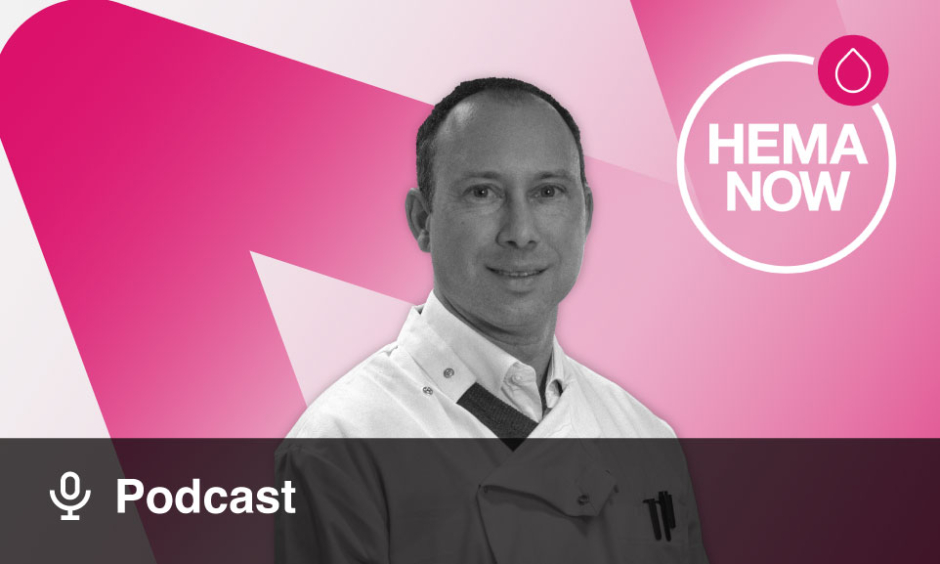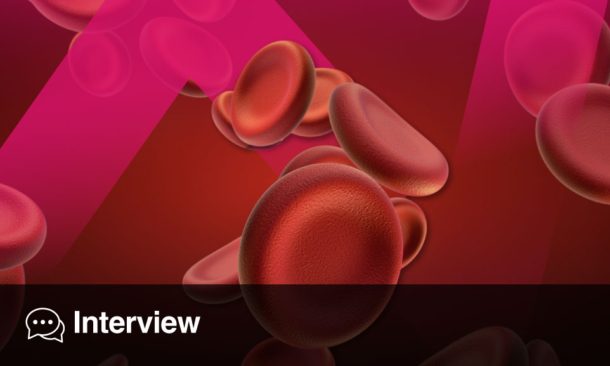Saskia Middeldorp | Professor of Medicine and Head of the Department of Internal Medicine, Radboud University Medical Center, Nijmegen, the Netherlands
Citation: EMJ Hematol. 2024;12[1]:59-62; https://doi.org/10.33590/emjhematol/QHZU2947.
![]()
Your current research at Radboud university medical center focuses on hereditary and acquired thrombophilia, and women’s issues in thrombosis and haemostasis. What motivated you to focus on these specific areas, and what are some of the most exciting advancements you’ve seen in this field recently?
Let me start with what drives me. I sort of coincidentally got into the field of clinical thrombosis and trials, looking at how to diagnose, prevent, and treat it. Everything you study gets more interesting because you start to know more, and then you get to know what you don’t know. So, that sort of happened naturally. However, as a clinician, as a doctor, I was very struck by the fact that there was hardly any high-level evidence for younger women, women with hormone-related thrombosis, or pregnancy-related thrombosis. So, at some point, I decided to try and create that evidence and think of how we can advance the field so that we can provide better evidence-based care to this relatively large group. That is how it all started. It’s quite challenging because it was often thought that it was very difficult to randomise pregnant women, for instance, like we did in the Highlow study. Or because, for women with a history of venous thrombosis or pulmonary embolism, we have no idea what dose of low molecular weight heparin to prescribe. So, we just decided to study and start doing it. It took 10 years for a reason. The drive for me, mainly, is the fact that it’s quite annoying that you can’t base your clinical advice to patients on evidence.
As an EHA Presidential Session Speaker, you are set to present the following talk at EHA 2024, ‘Conducting multinational RCTs in pregnancy to improve maternal health in thrombosis: it CAN be done’. What are the key challenges and considerations in conducting such complex trials, and can you highlight any findings from your recent work?
I think that the challenge is, although very prevalent in my practice, in order to collect data on many women, you need collaborations, and very often you need multinational collaborations. That is one barrier, because for collaborations you need colleagues who are willing to participate. I think the biggest challenge, really, is the money. So, we build academic thrombosis networks in which a lot of colleagues have become friends, and we share the same passion. For the Highlow study, for instance, I received starting money from a pharmaceutical company, which was really great. I failed to get national money from the Netherlands for some reason; I mean, that happens too. However, my French colleagues, who have a very good academic thrombosis network, were very successful. They acquired money for the France part. Then, a couple of years later, Irish colleagues got money for the Ireland part. So, at the end of the day, if you look at the amount of funding, it was still very small for such a big trial, but it was successful; although it took 10 years. I think if we had more money, we could get it done more quickly. Money is the main issue. Very often it is thought that ethical problems arise, but the trials I am doing are with agents, like low molecular weight heparin, that have been registered and are being used already in clinical practice, also in pregnant women. We know it’s safe, but it’s without evidence on optimal dosing. In fact, we have shown that women are very willing to participate in these trials and be randomised between one dose or the other. So, I think the main challenge is money.
You have been a principal investigator in several practice-changing trials such as ALIFE, ALIFE2, and Highlow. Could you share some key findings from these trials and how they have impacted clinical practice in the management of thrombosis?
In the Highlow study, we randomised women with a history of venous thromboembolism who became pregnant between a standard, prophylactic, low dose, that is derived from other indications like medical inpatients or prolonged prophylaxis after hip or knee surgery, or a higher dose that we hypothesised would be more effective to prevent recurrence in pregnancy or the postpartum period. We randomised more than 1,100 women in eight countries, and we found that the primary outcome of a recurrence over that entire study period was not significantly different, which was against our hypothesis. There was a 30% risk reduction, but it wasn’t significant, unfortunately. I think the most striking feature was the fact that we found that there was no numerical difference between the doses antepartum, but there was a statistically significant difference in the postpartum period. However, my practice has changed in that we used to provide a very high dose antepartum, and we now provide a low prophylactic dose during pregnancy, which facilitates neuraxial anaesthesia and all those things during delivery, and then escalate to an intermediate dose for the 6 weeks postpartum.
The ALIFE2 study is in a bit of a different field as it’s about thrombophilia and recurrent miscarriage. I’ve been interested in recurrent miscarriage because it is associated with antiphospholipid syndrome, which is an established relationship, but also in inherited thrombophilia, which is present in about 15% of the general population. These women, for many years, have been globally treated with low molecular weight heparin with the aim to improve pregnancy outcomes, and this has been a debate for a long time. Back in 2003 was the first ALIFE study, where we looked at unexplained inherited miscarriage. We randomised women to low molecular weight heparin, to low molecular weight heparin and aspirin, or to placebo. We didn’t find any effect, but we did find a signal in inherited thrombophilia, and that was the basis for ALIFE2, where we showed that in women with recurrent miscarriage and established inherited thrombophilia, low molecular weight heparin does not improve live birth. So, we should stop testing these women, we should stop prescribing low molecular weight heparin, and we should put all that money into research on how to improve outcomes in recurrent miscarriage. We should take it out of the haematology or thrombosis and haemostasis field. I think that impact should be huge, so I’m really an advocate for evidence-based medicine in maternal health.
If there’s no evidence, you should just go and get it. Make it yourself. Find your colleagues. Don’t be shy. Don’t be scared. Not everything I’ve done has been a success, but the successes are the ones that I try to cherish and celebrate.
Given your extensive involvement with the International Society of Thrombosis and Haemostasis (ISTH) and the INVENT-VTE network, how do you leverage these positions to drive advancements in thrombosis and haemostasis research, and what initiatives are you most excited about currently?
I’m an elected council member for ISTH, and that provides me with a large network, and also a podium to try and inspire people. I’m always open to mentoring people or providing my experiences, and I really hope to motivate younger people to not be turned off if it takes a bit longer to find success. Not everything you do will succeed, but if you get a couple of successes, then you can really make an impact. That is what ISTH does for me. INVENT-VTE is an international network of academic, national venous thromboembolism networks. It is a very powerful network to find colleagues in other countries, even the ones you don’t know yet, and to facilitate multinational trials. It doesn’t come with a lot of money, but there is some funding to, let’s say, acquire another country to participate in your research by providing some money for legal issues, the startup fees, and so on. The network also provides standard procedures, so to speak, for academic trials. For example, adjudication committee platforms and a core set of outcome data, so that you don’t have to rethink everything yourself, but can take the best bits out of it. That is what INVENT-VTE does in close association with ISTH.
You have received numerous accolades, including the Ham-Wasserman Lecture award and the Hijmans van den Bergh penning, in recognition of your contributions to internal medicine. How do these recognitions influence your work, and what has been your proudest achievement to date?
So, the Ham-Wasserman Lecture award was provided by the American Society of Hematology (ASH) in 2016 for “pioneering work in inherited thrombophilia.” That was an enormous honour, and is still an enormous honour, but I’m not sure if it impacts your work. It is more a recognition of what you have done. Of course, it is an outside confirmation that what drives you is actually being seen, and impacts people. So, I’m very proud of that. The Hijmans van den Bergh penning was not about thrombosis, but it was really about my contribution to internal medicine in the broadest sense. I’m very proud of that, because I’m the first woman, if you can believe it, that has been recognised in the 60-something years that it has existed. I’m proud that I can inspire young people by being a visible woman, by being both a clinician and an investigator, and some of the, let’s say, ‘softer’ parts, like having a family, and still having time to work out or enjoy life a little bit in the broader sense. Does it really impact your work? No, but it does impact the way you are being seen.
What key pieces of advice do you have for the next generation of aspiring haematologists wishing to pursue a successful career in this field?
Find a mentor. You can be very fond of your supervisor, and that is an extremely important person, but it is also nice to have a mentor outside of this. It can even be someone outside the field of medicine, who can talk to you about what drives you, what keeps you going, what is a drainer of energy, and what is giving you energy. To be quite honest, I sort of intuitively follow that path. Not all the time, of course, but we’re always in this rat race, and it’s really helpful to have some time to sit back and go back to the core, and ask the big questions. I think it’s also important to provide some advice to mentors, because it’s been such a thrill to work with younger people; to see some people who have stayed in the field and now are doing the same to young people today. I think that is fantastic.




